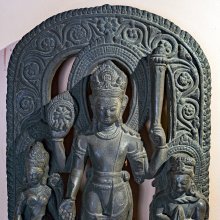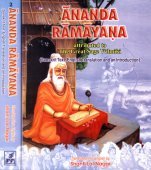Tulasi, Tulasī: 28 definitions
Introduction:
Tulasi means something in Hinduism, Sanskrit, Buddhism, Pali, the history of ancient India, Marathi, Jainism, Prakrit, Hindi, biology. If you want to know the exact meaning, history, etymology or English translation of this term then check out the descriptions on this page. Add your comment or reference to a book if you want to contribute to this summary article.
Alternative spellings of this word include Tulsi.
Images (photo gallery)
In Hinduism
Ayurveda (science of life)
Rasashastra (Alchemy and Herbo-Mineral preparations)
Source: Wisdom Library: Rasa-śāstraTulasī (तुलसी):—One of the sixty-eight Rasauṣadhi, very powerful drugs known to be useful in alchemical processes related to mercury (rasa), according to Rasaprakāśa-sudhākara (chapter 9).
Kalpa (Formulas, Drug prescriptions and other Medicinal preparations)
Source: archive.org: Science And Technology In Medievel India (kalpa)Tulasī (तुलसी) or Tulasīkalpa refers to Kalpa (medicinal preparation) described in the Auṣadhikalpa, as mentioned in A. Rahman’s Science and Technology in Medievel India: A bibliography of source materials in Sanskrit, Arabic and Persian.—Ancient and medieval India produced a wide range of scientific manuscripts and major contributions lie in the field of medicine, astronomy and mathematics, besides covering encyclopedic glossaries and technical dictionaries.—The Auṣadhikalpa is a medical work of the type of Materia Medica giving twenty-six medical preparations [e.g., Tulasī-kalpa] to be used as patent medicines against various diseases.
Source: Shodhganga: Edition translation and critical study of yogasarasamgrahaTulasī (तुलसी) [or Tuḷasī] refers to the medicinal plant known as “Ocimum tenuiflorum Linn.” and is dealt with in the 15th-century Yogasārasaṅgraha (Yogasara-saṅgraha) by Vāsudeva: an unpublished Keralite work representing an Ayurvedic compendium of medicinal recipes. The Yogasārasaṃgraha [mentioning tulasī] deals with entire recipes in the route of administration, and thus deals with the knowledge of pharmacy (bhaiṣajya-kalpanā) which is a branch of pharmacology (dravyaguṇa).
Unclassified Ayurveda definitions
Source: Wisdom Library: Āyurveda and botanyTulasī (तुलसी) is a Sanskrit word referring to Ocimum tenuiflorum (holy basil), from the Lamiaceae family. It is classified as a medicinal plant in the system of Āyurveda (science of Indian medicine) and is used throughout literature such as the Suśrutasaṃhita and the Carakasaṃhitā. It is a softly pubescent undershrub growing 30-60 centimeters in height. It grows throughout India. It has simple, opposite, elliptic, oblong, obtuse or acute leaves. The flowers are purplish in elongate recemes and grow in close whorls. The stamens are exserted and the fruits are nutlets.
According to the Rājanighaṇṭu (verse 10.148-149), Holy basil (tulasī) has the following synonyms: Surasā, Surabhi, Subhagā, Sugandhā, Suradundubhi, Surejyā, Viṣṇuvallabhā, Vaiṣṇavī, Haripriyā, Pretarākṣasī, Apetarākṣasī, Amṛtā, Devadundhubhi, Puṇyā, Pavitrā, Pāvanī, Pūtapattrī, Bahupattrī, Bhūtakeśī, Tīvrā, Bhūtaghnī, Garaghna, Kaṭhillaka, Kaṭhiñjara, Kāyasthā, Bhāravi, Tridaśamañjarī, Mañjarī and Gaurī.

Āyurveda (आयुर्वेद, ayurveda) is a branch of Indian science dealing with medicine, herbalism, taxology, anatomy, surgery, alchemy and related topics. Traditional practice of Āyurveda in ancient India dates back to at least the first millenium BC. Literature is commonly written in Sanskrit using various poetic metres.
Purana and Itihasa (epic history)
Source: archive.org: Puranic EncyclopediaTulasī (तुलसी).—(Holy Basil plant. General information. Tulasī is a plant held most sacred by the Hindus. There is a Purāṇic background for Tulasī attaining this spiritualistic importance. In fact it is Mahālakṣmī, wife of Viṣṇu, who had herself taken the form of Tulasī. There is a story about it in Devi Bhāgavata. (See full article at Story of Tulasī from the Puranic encyclopaedia by Vettam Mani)
Source: archive.org: Shiva Purana - English Translation1) Tulasī (तुलसी) refers to the “holy basil” plant, the leaves (patra) of which are used in the worship of Śiva, according to the Śivapurāṇa 2.1.13:—“[...] then the Ācamana shall be offered and cloth dedicated. Gingelly seeds, barley grains, wheat, green gram or black gram shall then be offered to Śiva with various mantras. Then flowers shall be offered to the five-faced noble soul. Lotuses, rose, Śaṅkha, and Kuśa flowers, Dhattūras, Mandāras grown in a wooden vessel, holy basil leaves (tulasī-patra) or Bilva leaves shall be offered to each of the faces in accordance with the previous meditation or according to one’s wish. By all means Śiva favourably disposed to His devotees shall be worshipped with great devotion. If other flowers are not available, Bilva leaves shall be used exclusively in the worship of Śiva”.
2) Tulasī (तुलसी) is the name of a plant which is used in the worship of Śiva, according to the Śivapurāṇa 2.1.14:—“[...] worldly pleasures (bhuktimukti) and salvation will be secured by a person who worships with Tulasī. Great valour (pratāpa) can be secured by worshipping with Arka or Kubjakalhāra flowers”.
3) Tulasī (तुलसी) refers to one of the sixteen celestial ladies (Divyanārī), according to the Śivapurāṇa 2.3.50 (“Description of fun and frolic”).—Accordingly, as Brahmā narrated to Nārada: “[...] Then the sixteen celestial ladies arrived there and saw the couple [i.e., Śiva and Pārvatī] with great respect. They were Sarasvatī, Lakṣmī, Sāvitrī, Jāhnavī, Aditi, Śacī, Lopāmudrā, Arundhatī, Ahalyā, Tulasī, Svāhā, Rohiṇī, Vasundharā, Śatarūpā, Saṃjñā and Rati. There were several virgins of the gods, Nāgas, and the sages. They were charming and attractive. Who can enumerate them? [...]”.
Source: Cologne Digital Sanskrit Dictionaries: The Purana IndexTulasī (तुलसी).—Sacred to Hari;1 on the chest of Viṣṇu.2
- 1) Bhāgavata-purāṇa I. 19. 6; V. 3. 6; X. 30. 7; XI. 30. 41.
- 2) Brahmāṇḍa-purāṇa IV. 9. 80-2; 17. 74.

The Purana (पुराण, purāṇas) refers to Sanskrit literature preserving ancient India’s vast cultural history, including historical legends, religious ceremonies, various arts and sciences. The eighteen mahapuranas total over 400,000 shlokas (metrical couplets) and date to at least several centuries BCE.
Vaishnavism (Vaishava dharma)
Source: Pure Bhakti: Bhajana-rahasya - 2nd EditionTulasī (तुलसी) refers to:—A sacred plant whose leaves and blossoms are used by Vaiṣṇavas in the worship of Śrī Kṛṣṇa; the wood is also used for chanting beads and neck beads. (cf. Glossary page from Bhajana-Rahasya).
Source: Pure Bhakti: Arcana-dipika - 3rd EditionTulasī (तुलसी) refers to a “sacred plant” (whose leaves and blossoms are used by Vaiṣṇavas in the worship of Śrī kṛṣṇa), according to the Arcana-dīpikā (manual on deity worship).—Accordingly, while explaining the rules for picking flowers and Tulasī leaves:—Pay obeisances to Śrī Bhagavān, beg for His mercy, and pick flowers and tulasī according to the proper rules. It is prohibited to collect tulasī leaves without having bathed. Pick tulasī only after taking morning bath. One can pick flowers before bathing, as there is no prohibition regarding picking flowers before one’s bath. If one is unable to take bath, one should put on fresh cloth, bathe by meditation (mantra-snāna), and then, with pure consciousness, pick flowers and tulasī leaves.
Special considerations for tulasī:—After bathing and performing āhnika (the chanting of the dīkṣā-mantras), bathe tulasī [by pouring water on her soil], while chanting her bathing mantra. Then offer her praṇāma while chanting her praṇāma-mantra. Then, while chanting the mantra for picking tulasī (cayana-mantra), pick the leaf that is joined with the stem, or else pick soft mañjarīs (flower buds) that are joined with the leaves and stem. each leaf is to be picked with the right hand, individually and very carefully, so that tulasī-devī will not experience any kind of pain. After picking her leaves, recite the prayers begging for forgiveness (aparādha-kṣamāprārthanā-mantra), for having caused her any pain. [...] For others (non-Vaiṣṇavas), picking tulasī is prohibited on certain days. For pure Vaiṣṇavas though, picking tulasī is only prohibited on the day of dvādaśī. one may use unoffered tulasī leaves from the previous day or dried tulasī leaves picked many days before. One should not put tulasī on the feet of śrī gurudeva.
Moreover, while picking tulasī, do not pick with the pointer finger and do not use your fingernails. One should pick tulasī leaves with the sole intention of using them in the service of Bhagavān, nothing else. One should not pick flowers or tulasī once the sun has started to set.
Source: Pure Bhakti: Brhad BhagavatamrtamTulasī (तुलसी) refers to:—A sacred plant most dear to Śrī Kṛṣṇa, whose leaves and blossoms are used by Vaiṣṇavas in the worship of Śrī Kṛṣṇa; tulasī wood is also used for chanting beads and neck beads (tulasī-mālā). (cf. Glossary page from Śrī Bṛhad-bhāgavatāmṛta).

Vaishnava (वैष्णव, vaiṣṇava) or vaishnavism (vaiṣṇavism) represents a tradition of Hinduism worshipping Vishnu as the supreme Lord. Similar to the Shaktism and Shaivism traditions, Vaishnavism also developed as an individual movement, famous for its exposition of the dashavatara (‘ten avatars of Vishnu’).
Pancaratra (worship of Nārāyaṇa)
Source: archive.org: Catalogue of Pancaratra Agama TextsTulasī (तुलसी) refers to the “basil plant” which is very sacred, according to the sixth chapter of the Agastyasaṃhitā (agastya-suīkṣṇa-saṃvāda edition), an ancient Pāñcarātra Āgama text dealing with the worship of Rāma, Sītā, Lakṣmaṇa and Hanumān.—Description of the chapter [tulasīmāhātmya]: Agastya says that the best of all flowers and leaves is tulasī because once Tulasī did penance and received as reward Janārdana (i.e., Nārāyaṇa) for her husband; just as Sītā is the beloved of Rāma so is tulasī holiest to Him (Rāma). Whoever worships Rāma daily with tulasī leaf—no matter what his āśrama—goes to Brahman. Various ways of worshipping Rāma with tulasī leaf are then outlined, and their respective rewards [phala] are mentioned. Wherever tulasī plants grow along with other flowers, there Rāma and Sītā are believed to be present; those who grow these plants in their gardens will win immortality by this act alone. [...]

Pancaratra (पाञ्चरात्र, pāñcarātra) represents a tradition of Hinduism where Narayana is revered and worshipped. Closeley related to Vaishnavism, the Pancaratra literature includes various Agamas and tantras incorporating many Vaishnava philosophies.
India history and geography
Source: Project Gutenberg: Castes and Tribes of Southern India, Volume 1Tulasi or Tulashishta is one of the exogamous septs (divisions) among the Komatis (a trading caste of the Madras Presidency). Tulasi refers to the plant Tulasi (Ocimum sanctum). The Komatis are said to have originally lived, and still live in large numbers on the banks of the Godavari river. One of the local names thereof is Gomati or Gomti, and the Sanskrit Gomati would, in Telugu, become corrupted into Komati. The sub-divisions are split up into septs (viz., Tulasi), which are of a strictly exogamous character.

The history of India traces the identification of countries, villages, towns and other regions of India, as well as mythology, zoology, royal dynasties, rulers, tribes, local festivities and traditions and regional languages. Ancient India enjoyed religious freedom and encourages the path of Dharma, a concept common to Buddhism, Hinduism, and Jainism.
Biology (plants and animals)
Source: Google Books: CRC World Dictionary (Regional names)1) Tulasi in India is the name of a plant defined with Ocimum americanum in various botanical sources. This page contains potential references in Ayurveda, modern medicine, and other folk traditions or local practices It has the synonym Ocimum canum var. integrifolium Engl. (among others).
2) Tulasi is also identified with Ocimum basilicum It has the synonym Plectranthus barrelieri (Roth) Spreng. (etc.).
3) Tulasi is also identified with Ocimum gratissimum.
Example references for further research on medicinal uses or toxicity (see latin names for full list):
· Beskr. Guin. Pl. (1827)
· Amoenitates academicae (1755)
· Proceedings of the Indian Academy of Sciences (1985)
· Prodromus Systematis Naturalis Regni Vegetabilis (DC.) (1848)
· Thaiszia (1997)
· Journal of the Indian Botanical Society (1986)
If you are looking for specific details regarding Tulasi, for example pregnancy safety, extract dosage, health benefits, chemical composition, diet and recipes, side effects, have a look at these references.

This sections includes definitions from the five kingdoms of living things: Animals, Plants, Fungi, Protists and Monera. It will include both the official binomial nomenclature (scientific names usually in Latin) as well as regional spellings and variants.
Languages of India and abroad
Pali-English dictionary
Source: BuddhaSasana: Concise Pali-English Dictionarytulasī : (f.) the basil plant.
Source: Sutta: The Pali Text Society's Pali-English DictionaryTulasi, (Derivation unknown) basil (common or sweet) J. V, 46 (°gahana a thicket of b.; v. l. tūlasi); VI, 536 (tuḷasi=tuḷasigaccha). (Page 305)

Pali is the language of the Tipiṭaka, which is the sacred canon of Theravāda Buddhism and contains much of the Buddha’s speech. Closeley related to Sanskrit, both languages are used interchangeably between religions.
Marathi-English dictionary
Source: DDSA: The Molesworth Marathi and English Dictionarytulasī (तुलसी).—f (S) A shrub venerated by the Hindus, Holy basil, Ocymum sanctum. It is fabled to be a female metamorphosed; but there are numerous accounts. Some compounds are tulasīpūjā, tula- sīmañjarī, tulasīmālā, tulasīvana, tulasīhāra; and for phrases see tuḷasa.
Source: DDSA: The Aryabhusan school dictionary, Marathi-Englishtulasī (तुलसी).—See tuḷasa.
Marathi is an Indo-European language having over 70 million native speakers people in (predominantly) Maharashtra India. Marathi, like many other Indo-Aryan languages, evolved from early forms of Prakrit, which itself is a subset of Sanskrit, one of the most ancient languages of the world.
Sanskrit dictionary
Source: DDSA: The practical Sanskrit-English dictionaryTulasi (तुलसि).—(Metrically for tulasī),
-tulasikā See तुलसी (tulasī); वाचश्च नस्तुलसिवद्यदि तेऽङ्घ्रिशोभाः (vācaśca nastulasivadyadi te'ṅghriśobhāḥ) Bhāgavata 3.15.49; तुलसिका- दूर्वाङ्कुरैरपि (tulasikā- dūrvāṅkurairapi)... परितुष्यसि (parituṣyasi) 5.3.6.
--- OR ---
Tulasī (तुलसी).—[tulāṃ sādṛśyaṃ syati, so-ka gaurā° ṅīp śaṃkadhvā. Tv.] The holy basil held in veneration by the Hindus, especially by the worshippers of Visnu.
Source: Cologne Digital Sanskrit Dictionaries: Shabda-Sagara Sanskrit-English DictionaryTulasī (तुलसी).—f. (-sī) A small shrub held in veneration by the Hindus, Tulasi or holy basil, (Ocymum sanctum.) E. tulā resemblance, and ṣo to destroy, affixes ṅa and ṅīp; being unparalleled: this plant is said to be a female metamorphosed. tulāṃ sādṛśyaṃ syati so-ka gaurā0 ṅīṣ .
Source: Cologne Digital Sanskrit Dictionaries: Monier-Williams Sanskrit-English Dictionary1) Tulasi (तुलसि):—metrically for sī, [Bhāgavata-purāṇa iii, 15, 49.]
2) Tulasī (तुलसी):—[from tulasi] f. holy basil (small shrub venerated by Vaiṣṇavas; commonly Tulsī), [Bhāgavata-purāṇa; Vāyu-purāṇa] and, [Padma-purāṇa] (produced from the ocean when churned), [Brahma-purāṇa] (produced from the hair of the goddess Tulasī, [ii, 19].)
Source: Cologne Digital Sanskrit Dictionaries: Yates Sanskrit-English DictionaryTulasī (तुलसी):—(sī) 3. f. Holy basil (Ocymum sanctum).
Source: DDSA: Paia-sadda-mahannavo; a comprehensive Prakrit Hindi dictionary (S)Tulasī (तुलसी) in the Sanskrit language is related to the Prakrit word: Tulasī.
[Sanskrit to German]
Sanskrit, also spelled संस्कृतम् (saṃskṛtam), is an ancient language of India commonly seen as the grandmother of the Indo-European language family (even English!). Closely allied with Prakrit and Pali, Sanskrit is more exhaustive in both grammar and terms and has the most extensive collection of literature in the world, greatly surpassing its sister-languages Greek and Latin.
Hindi dictionary
Source: DDSA: A practical Hindi-English dictionaryTulasī (तुलसी) [Also spelled tulsi]:—(nf) the holy basil plant —Ocymum sanctum; —[dala/patra] a basil leaf; —[vana] a basil grove.
...
Prakrit-English dictionary
Source: DDSA: Paia-sadda-mahannavo; a comprehensive Prakrit Hindi dictionaryTulasī (तुलसी) in the Prakrit language is related to the Sanskrit word: Tulasī.
Prakrit is an ancient language closely associated with both Pali and Sanskrit. Jain literature is often composed in this language or sub-dialects, such as the Agamas and their commentaries which are written in Ardhamagadhi and Maharashtri Prakrit. The earliest extant texts can be dated to as early as the 4th century BCE although core portions might be older.
Kannada-English dictionary
Source: Alar: Kannada-English corpusTulasi (ತುಲಸಿ):—[noun] any of a genus (Ocimum) of fragrant plants of the mint family, esp. a white-flowered garden herb (Ocimum sanctum which is religiously regarded as a goddess).
--- OR ---
Tuḷasi (ತುಳಸಿ):—[noun] any of a genus (Ocimum) of fragrant plants of the mint family, esp. a white-flowered garden herb, Ocimum sanctum, which is religiously regarded as a goddess.
Kannada is a Dravidian language (as opposed to the Indo-European language family) mainly spoken in the southwestern region of India.
Nepali dictionary
Source: unoes: Nepali-English DictionaryTulasī (तुलसी):—n. Bot. basil plant;
Nepali is the primary language of the Nepalese people counting almost 20 million native speakers. The country of Nepal is situated in the Himalaya mountain range to the north of India.
See also (Relevant definitions)
Starts with (+28): Tulasi patta, Tulasi-paate, Tulasi-pate, Tulasia, Tulasicandrika, Tulasidamabhushana, Tulasidanapaddhati, Tulasidasa, Tulasidvadashi, Tulasidvesha, Tulasika, Tulasikalpa, Tulasikashta, Tulasikashthamahatmya, Tulasikatte, Tulasikavaca, Tulasiko-motha, Tulasiko-patra, Tulasimahatmya, Tulasimala.
Ends with (+65): Adavitulasi, Aranyatulasi, Bana tulasi, Banatulasi, Bantulasi, Bhoo tulasi, Bhoo-tulasi, Bhu-tulasi, Bhumi-tulasi, Bhutulasi, Bisva tulasi, Bisvatulasi, Bon tulasi, Devara tulasi, Dhala-tulasi, Elumicham tulasi, Elumichan tulasi, Elumichantulasi, Ganga-tulasi, Gola tulasi.
Full-text (+297): Kathinjara, Tulasivivaha, Tulasika, Tulasivrindavana, Tulasipattra, Naganaman, Tulasimanjari, Vanala, Asrarjjaka, Bhu-tulasi, Parnasha, Tulasidvesha, Ram-tulasi, Alpapatra, Nimma-tulasi, Pretarakshasi, Prasthapushpa, Tridashamanjari, Galantika, Tavadisu.
Relevant text
Search found 57 books and stories containing Tulasi, Tulasī, Tuḷasī, Tuḷasi; (plurals include: Tulasis, Tulasīs, Tuḷasīs, Tuḷasis). You can also click to the full overview containing English textual excerpts. Below are direct links for the most relevant articles:
Garga Samhita (English) (by Danavir Goswami)
Verse 2.16.37 < [Chapter 16 - The Worship of Tulasī]
Verse 2.16.18 < [Chapter 16 - The Worship of Tulasī]
Verses 2.16.27-28 < [Chapter 16 - The Worship of Tulasī]
Bhakti-rasamrta-sindhu (by Śrīla Rūpa Gosvāmī)
Verse 1.2.205 < [Part 2 - Devotional Service in Practice (sādhana-bhakti)]
Verse 2.1.381 < [Part 1 - Ecstatic Excitants (vibhāva)]
Verse 3.1.23 < [Part 1 - Neutral Love of God (śānta-rasa)]
Hari-bhakti-kalpa-latikā (by Sarasvati Thkura)
Text 21 < [First Stabaka]
The Padma Purana (by N.A. Deshpande)
Chapter 24 - The Greatness of Tulasī and Dhātrī < [Section 7 - Kriyāyogasāra-Khaṇḍa (Section on Essence of Yoga by Works)]
Chapter 22 - The Greatness of Tulasī < [Section 4 - Brahma-khaṇḍa (Section on Brahman)]
Chapter 23 - The Importance of Tulasī < [Section 6 - Uttara-Khaṇḍa (Concluding Section)]
Bhajana-Rahasya (by Srila Bhaktivinoda Thakura Mahasaya)
Śrī Gaudīya Vaiṣṇavas’ Saṅkṣepa-arcana-paddhati
Text 32 < [Chapter 1 - Prathama-yāma-sādhana (Niśānta-bhajana–śraddhā)]
Text 7 < [Chapter 6 - Ṣaṣṭha-yāma-sādhana (Sāyaṃ-kālīya-bhajana–bhāva)]
Haribhakti-sudhodaya (by Tridandi Sri Bhakti Prajnan Yati Maharaj)
Related products
(+1 more products available)






